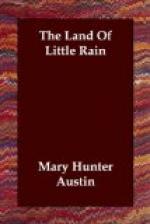He had come into the keeping of the Paiutes as a hostage for the long peace which the authority of the whites made interminable, and, though there was now no order in the tribe, nor any power that could have lawfully restrained him, kept on in the old usage, to save his honor and the word of his vanished kin. He had seen his children’s children in the borders of the Paiutes, but loved best his own miles of sand and rainbow-painted hills. Professedly he had not seen them since the beginning of his hostage; but every year about the end of the rains and before the strength of the sun had come upon us from the south, the medicine-man went apart on the mountains to gather herbs, and when he came again I knew by the new fortitude of his countenance and the new color of his reminiscences that he had been alone and unspied upon in Shoshone Land.
To reach that country from the campoodie, one goes south and south, within hearing of the lip-lip-lapping of the great tideless lake, and south by east over a high rolling district, miles and miles of sage and nothing else. So one comes to the country of the painted hills,—old red cones of craters, wasteful beds of mineral earths, hot, acrid springs, and steam jets issuing from a leprous soil. After the hills the black rock, after the craters the spewed lava, ash strewn, of incredible thickness, and full of sharp, winding rifts. There are picture writings carved deep in the face of the cliffs to mark the way for those who do not know it. On the very edge of the black rock the earth falls away in a wide sweeping hollow, which is Shoshone Land.
South the land rises in very blue hills, blue because thickly wooded with ceanothus and manzanita, the haunt of deer and the border of the Shoshones. Eastward the land goes very far by broken ranges, narrow valleys of pure desertness, and huge mesas uplifted to the sky-line, east and east, and no man knows the end of it.
It is the country of the bighorn, the wapiti, and the wolf, nesting place of buzzards, land of cloud-nourished trees and wild things that live without drink. Above all, it is the land of the creosote and the mesquite. The mesquite is God’s best thought in all this desertness. It grows in the open, is thorny, stocky, close grown, and iron-rooted. Long winds move in the draughty valleys, blown sand fills and fills about the lower branches, piling pyramidal dunes, from the top of which the mesquite twigs flourish greenly. Fifteen or twenty feet under the drift, where it seems no rain could penetrate, the main trunk grows, attaining often a yard’s thickness, resistant as oak. In Shoshone Land one digs for large timber; that is in the southerly, sandy exposures. Higher on the table-topped ranges low trees of juniper and pinon stand each apart, rounded and spreading heaps of greenness. Between them, but each to itself in smooth clear spaces, tufts of tall feathered grass.
This is the sense of the desert hills, that there is room enough and time enough. Trees grow to consummate domes; every plant has its perfect work. Noxious weeds such as come up thickly in crowded fields do not flourish in the free spaces. Live long enough with an Indian, and he or the wild things will show you a use for everything that grows in these borders.




